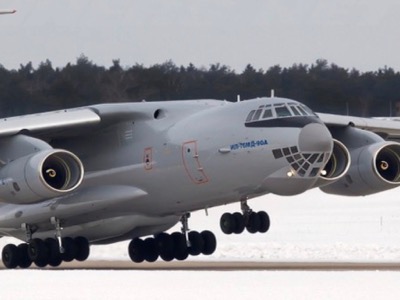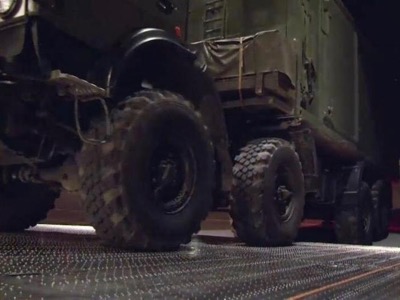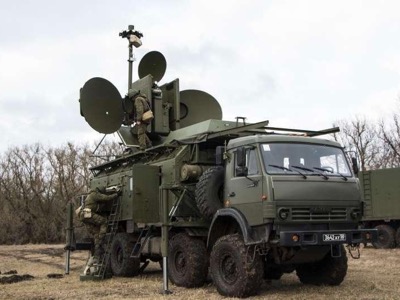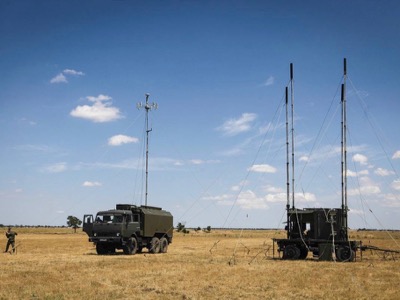Russia is following through with the decisions it took after the Russian Il-20 plane was destroyed on 17 September 2018 during a joint British- French – Israeli attack. The Russian Minister for Defense is supplying the Syrian army not just with S-300 (superior system of anti-air defence), but also with all material for electronic warfare. At the same time, the Pentagon is withdrawing its Patriots from several countries in the region. The balance of forces is profoundly modified.

To improve the security of Russian soldiers deployed in Syria, two IL-76 MD planes for heavy transport, landed on Monday evening (24 September 2018) at the Russian air base at Latakia. It appears that both planes were loaded with material for interference.
On Tuesday evening (25 September 2018) 6 more IL-76 MD planes, escorted by 8 fighter planes (Su 30 SM and Su 35 S) landed in Syria. Al-Masdar News presented the first photos posted by Uralinform.Ru when the Russian planes were unloading.

The material unloaded seems to be of the type 1RL257 Krasukha-4. This material has a special system of interference: R-330ZH Zhitel. This will protect Syria against the enemy systems of electronic warfare (Electronic Warfare – EW). The EW includes support and attack for air and missile attacks plus collecting information on the entire radio electronic spectrum (RWR / ESM / Elinta), etc.

This equipment for interference will be provided to the Syrian Army. So will air space management and the S 300 missiles systems. The antennae, transmitters, servers for analysis and action centre which constitute the Krasukha-4 complex are principally meant to interfere with radars on the ground as well as those on the following types of planes:
• AWACS (Airborne Warning and Control Systems) planes;
• Reconnaissance planes (Israeli Gulfstream G550, British Sentinel R1, the U.S. RC-135, P-8A Poseidon and E-8 Joint-Joint Surveillance Target Attack Radar System); and
• Reconnaissance drones (planes without pilots): the US RQ-170 Sentinel, RQ-4 Global Hawk, the US MQ-1 Predator, and the Israeli Heron, Eitan, Hermes 900 fitted out with a radar to synthesise the opening.

The Krasukha-4 system also interferes with communications of US satellites, Lacrosse or Onyx, placed in low orbit. This creates an impenetrable curtain. Fighter planes will also have their radars, radio stations or data channels blocked. This type of interference also affects the radar equipment that guides missiles launched by these planes. The Electronic Combat range - the real distance of interference – ranges from 150 to 300 km.
The R-330ZH Zhitel is meant to interfere with communication networks, in particular, GSM 1900 mobile phones and Inmarsat and Iridium telephone satellites. This system functions in the frequency range of 1000 to 2000 MHz. The equipment for listening to recordings calculates the geographic coordinates of network users and analyses the parameters of the signal (SIGINT). This enables selective interference of the station sending out the signal (ECM : electronic countermeasures).

The R 330ZH Zhitel can also follow the dialogue (emission-reception) between satellites of the navigation network, NAVSTAR (GPS), and the vehicle for attack (planes, helicopters, cruise missiles, guided bombs etc). It can thus disrupt the reception of signals sent or received by means of enemy attack. As its range of action is quite limited (20-30 kilometres), to cover a group of targets spread across a large area, we need several R-330ZH Zhitel stations for interference, working in a network.
The Russian army gives details on the “shield of invisibility” created by a single set up Krasukha-4 or R-330ZH Zhitel. The cover is for:
– 11 to 19 km against the radar of reconnaissance planes;
– 16 to 41 km against the detection and guidance systems of engines on board fighter planes and cruise missiles
– 15 to 25 km against detection by satellite
The United States, the United Kingdom, France and Israel all have cruise missiles capable of going around the Syrian coastline (in the Mediterranean) and penetrating Syrian territory from Jordan, Israel, Iraq and Turkey. Consequently, to guarantee an impenetrable defence, Russia should provide dozens of these systems (4-5 battalions of interference) to the Syrian Army.

 Articles by this author
Articles by this author Send a message
Send a message






















Stay In Touch
Follow us on social networks
Subscribe to weekly newsletter